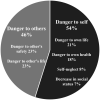Compulsory admissions of patients with mental disorders: State of the art on ethical and legislative aspects in 40 European countries
- PMID: 32829740
- PMCID: PMC7576531
- DOI: 10.1192/j.eurpsy.2020.79
Compulsory admissions of patients with mental disorders: State of the art on ethical and legislative aspects in 40 European countries
Abstract
Background: Compulsory admission procedures of patients with mental disorders vary between countries in Europe. The Ethics Committee of the European Psychiatric Association (EPA) launched a survey on involuntary admission procedures of patients with mental disorders in 40 countries to gather information from all National Psychiatric Associations that are members of the EPA to develop recommendations for improving involuntary admission processes and promote voluntary care.
Methods: The survey focused on legislation of involuntary admissions and key actors involved in the admission procedure as well as most common reasons for involuntary admissions.
Results: We analyzed the survey categorical data in themes, which highlight that both medical and legal actors are involved in involuntary admission procedures.
Conclusions: We conclude that legal reasons for compulsory admission should be reworded in order to remove stigmatization of the patient, that raising awareness about involuntary admission procedures and patient rights with both patients and family advocacy groups is paramount, that communication about procedures should be widely available in lay-language for the general population, and that training sessions and guidance should be available for legal and medical practitioners. Finally, people working in the field need to be constantly aware about the ethical challenges surrounding compulsory admissions.
Keywords: Awareness; European Psychiatric Association (EPA); National Psychiatric Associations (NPAs); communication; compulsory admission; education; ethics and human rights; involuntary admission; legal model; medical model; psychiatry in Europe; stigma.
Conflict of interest statement
The authors declare that there is no conflict of interest.
Figures
References
-
- Dressing H, Salize HJ. Compulsory admission of mentally ill patients in European Union Member States. Soc Psychiatry Psychiatr Epidemiol. 2004;39(10):797–803. - PubMed
-
- Priebe S, Katsakou C, Glöckner M, Dembinskas A, Fiorillo A, Karastergiou A, et al. Patients’ views of involuntary hospital admission after 1 and 3 months: prospective study in 11 European countries. Br J Psychiatry. 2010;196(3):179–185. - PubMed
-
- Fiorillo A, De Rosa C, Del Vecchio V, Jurjanz L, Schnall K, Onchev G, et al. How to improve clinical practice on involuntary hospital admissions of psychiatric patients: suggestions from the EUNOMIA study. Eur Psychiatry. 2011;26(4):201–207. - PubMed
-
- Georgieva I, Whittington R, Lauvrud C, Steinert T, Wikman S, Lepping P, et al. International variations in mental-health law regulating involuntary commitment of psychiatric patients as measured by the Mental Health Legislation Attitudes Scale. Med Sci Law. 2019;59(2):104–114. - PubMed
-
- Gaebel W, Groẞimlinghaus I, Kerst A, Cohen Y, Hinsche-Böckenholt A, Johnson B, et al. European Psychiatric Association (EPA) guidance on the quality of eMental health interventions in the treatment of psychotic disorders. Eur Arch Psychiatry Clin Neurosci. 2016;266:125–137. - PubMed
MeSH terms
LinkOut - more resources
Full Text Sources
Medical
Research Materials


